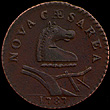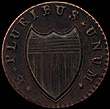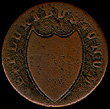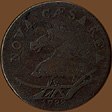New Jersey Coppers 1786-1790
obverse |
|
reverse |
| |||
1787 Maris 48-g probably Rahway 1787 Goadsby and Cox NJ Copper
Obverse: NOVA CÆSAREA 1787
Reverse: * E * PLURIBUS * UNUM *
Weight: 148.0 g (9.59 grams) Diameter: 28.0 mm Reverse die alignment: 190°
Comments: The minting location of this specific example is not clear. The obverse and reverse dies are now assigned to the Rahway mint where this combination was first struck in the latter half of 1787. Additional quantities were produced on larger sized planchets by Walter Mould in Morristown, when the Rahway press (and some of their dies) were sent to him in December 1787. As Mould had also acquired several thousand smaller Rahway planchets it is possible some of the smaller sized 48-g's were minted at Morristown along with the larger planchet variety. The Rahway equipment was returned in February but by June Matthias Ogden had taken possession of the Rahway equipment and dies and transported them to Elizabethtown, where he continued minting coppers until 1790. The posibility exists that Ogden also minted some of this variety.
According to Hodder's 1989 preliminary research early and lighter 48-g coppers were produced at Rahway while later "broad and light" and then "broad and heavy" planchet 48-g coppers were minted by Ogden. In 1993 he briefly mentioned this variety in his article uncovering the transporting of the Rahway press to Morristown, stating that late issues of the 48-g on a broad planchet were probably produced by Ogden at Morristown. This coin is associated with the horse facing left variety, see that entry (Maris 49-f) for further details concerning the reverse g die.
Obverse 48 is a variety with a shorter curved beam on the plow. Note that the wreath line under the horse is short and does not extend into the area under the mane. It was joined with reverses f and g (which are also found on horse facing left varieties) and with reverse X. The only other right facing horse in this group is obverse 37 (joined with f and X), they can be easily distinguished since obverse 37 has a wreath line extending the entire length of the horse's bust.
The shield on reverse g has a very pronounced left and right (dexter and sinister) points, that are higher than the central point. The only similar reverse in this group is reverse f. The can be distinguished in that on reverse g the left (dexter) point is at the end stroke of the R while the right (sinister) point is directed towards the bottom curve of the S in the legend. On reverse f the points are at the start of the R and the star. On reverse g the vertical lines on the shield, known as pales, are grouped in four (some varieties have groups of three). Hodder has mentioned a die clash that is evidenced by a diagonal line starting at the bottom of the far right set of stripes and moving diagonally upward to the top left (dexter) point on the shield. There is also a die crack from the top of the first vertical stroke of the M to a deticle at the rim and a small die crack inside the bottom curve of the letter S from the serif to the center of the letter.
Provenance: From the Robert H. Gore, Jr. Numismatic Collection.
obverse |
|
reverse |
| |||
1787 Maris 48-g probably Rahway 1787 Goadsby and Cox NJ Copper
Obverse: NOVA CÆSAREA 1787
Reverse: * E * PLURIBUS * UNUM *
Weight: 142.9 g (9.26 grams) Diameter: 27.5 mm Reverse die alignment: 160°
Comments: This is a second more circulated example of the variety discussed above. The shield is too worn to detect the die crack. There does not appear to be a crack over the M as on the previous example.
Provenance: From the Robert H. Gore, Jr. Numismatic Collection.
obverse |
|
reverse |
| |||
1788 Maris 49-f Horse facing left NJ Copper
Obverse: NOVA CÆSAREA 1788
Reverse: * E * PLURIB[US *] UNUM *
Weight: 135.1 g (8.75 grams) Diameter: 28.6 mm Reverse die alignment: 190°
Comments: This is one of three horse facing left varieties. Traditionally these were attributed to Goadsby working independently at Rahway after obtaining a legal writ against Cox on November 6, 1787. It was assumed he continued minting coins until the middle of 1788. However, Hodder has recently shown that Goadsby transported the Rahway press with some copper ingots and blank planchets and probably some dies to Walter Mould's Morristown mint (by December 1787). The press remained there until the start of February 1788 when it was send back to Rahway presumably with the dies (Cox was out of jail by this time). In March the unused copper was returned. A few months thereafter (in June), due to continued legal troubles between Goadsby and Cox, the man who had secured their bond, Matthias Ogden, obtained all the Rahway equipment which he took to his home on Water Street in Elizabethtown, where he started minting coppers until 1790. Based on this newly discoverd scenario about the only person who could not have minted these coins is the person they have been traditionally assigned to, since he did not have a coin press while Cox was in jail! Currently the mystery of the left facing coppers had not been solved.
The obverse is the distinctive horse facing left. Note the plow is more complex than usual with two cross bars connecting the handles. Maris notes that the coulter is fashioned from a sword (the hilt is visible above the beam). Obverse 49 has a larger horse head than the other two varieties (obverses 50 and 51). Obverse 51 is distinctive in that it is on a smaller planchet and has the smallest sized head. Obverse 49 can be distinguished from 50 in that on obverse 49 there is much space between the end of the plow beam and the start of the legend (however the legend ends closer to the plow handles) while on obverse 50 the legend starts and ends very close to the plow. Obverse 49 is only combined with reverse f.
Reverse f is found in combinations with obverses 49 and 50 as well as the horse facing right obverse 37. The shield on reverse f has left and right (dexter and sinister) points that are higher than the central point. The only similar reverse in this group is reverse g. They can be distinguished in that on reverse g the left (dexter) point is at the end stroke of the R while the right (sinister) point is directed towards the bottom curve of the S in the legend. On reverse f the points are at the first vertical stroke of the R and the star. Also, as Maris states, the stars are smaller on reverse f.
Provenance: From the Robert H. Gore, Jr. Numismatic Collection.
| New Jersey Coppers: p. 1 | Section Contents | New Jersey Coppers: p. 3 |
|
For viewing tips and information on optimal computer settings click
here.
For questions or comments contact Special Collections by: |





